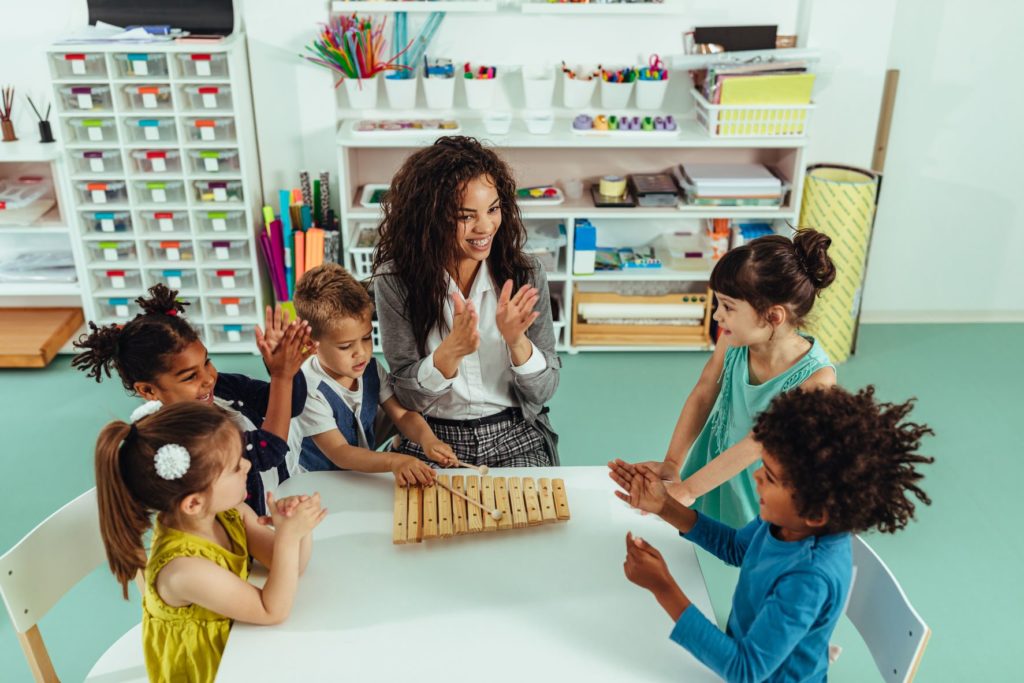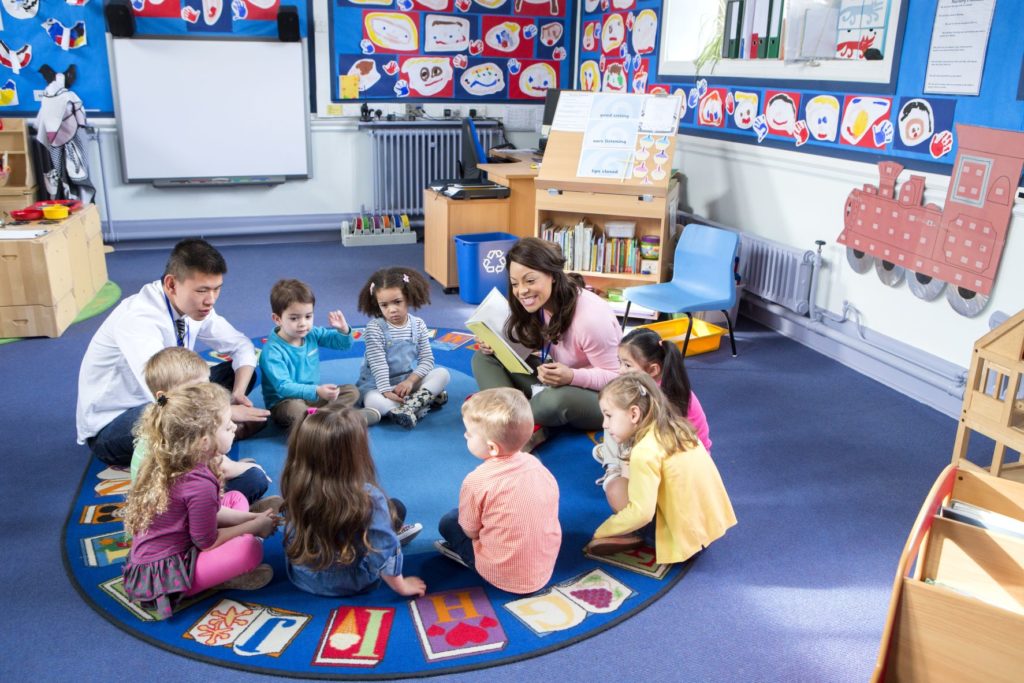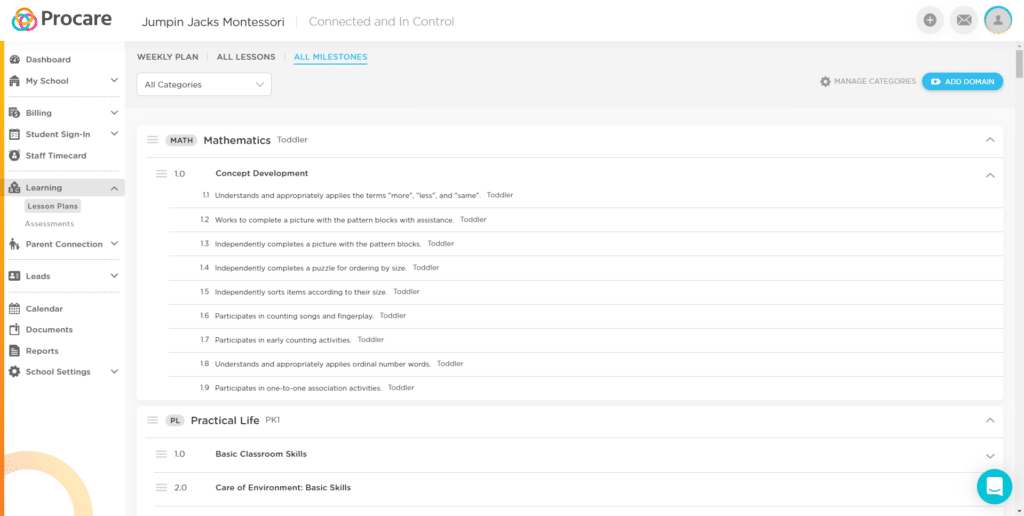
A well-designed preschool classroom is the foundation of a play-based, intentional education curriculum. Planning ahead to set up your classroom to facilitate kids’ curiosity, exploration and play will help you stay organized, encourage independence and make the most of the educational opportunities at your center.
Today we’ll look at how you can organize your classroom for an optimal learning experience in your preschool. We’ll learn why classroom design is so important, then we’ll share six expert tips on how you can develop your classroom design and organization for intentional education.
Let’s dive in!
Why Does Preschool Classroom Setup Matter?
It’s said that the child has three teachers: the child’s parents are the first, you as the educator are the second and the third is the classroom. Kids are driven by natural curiosity to explore their environment, so a well-designed classroom harnesses this curiosity to afford learning opportunities that kids will seek out for themselves.
Play-based learning is most effective when educators set up an engaging and activity-rich preschool classroom. This means using intentional design to support age-appropriate activities and learning opportunities across all four developmental domains.
When the classroom is set up with care, kids’ natural energy will be channeled into productive activities while everyone plays safely. Everyone will always have something to do and disruptions will be minimized. Kids will find it easy to understand how to set up their own activities and tidy up when they’re done.
Six Preschool Classroom Ideas for Intentional Educators
Set Up Your Preschool Classroom for Multiple Play Styles
As they develop, children progress through several stages of play, incorporating more socialization and complexity as they learn and grow. An intentional preschool classroom is set up to accommodate all the different ways kids play.
- Solitary play can happen at any age, but kids up to age 2 or two and 2.5 are likely to play this way most of the time.
- Spectator/onlooker play involves one or more kids watching while other children play. Kids between 2 and 3 prefer this type of play.
- Parallel play sees children playing next to each other, but not with each other. It is commonly seen when kids are between 2 and 4.
- Associative play begins around age 3 to 5, when children begin to interact with each other in play, but are still not playing in a coordinated way.
- Cooperative Play is the final and most complex stage of play, seen in kids aged 5 and older. In this stage, children play cooperative games with rules and defined roles.
The activity centers should allow for all five stages of play to occur, with cozy nooks for solitary players to work without disruption, as well as more open areas where kids can play together without crowding.
Areas for active, social and dramatic play should be separated from more quiet, low-key play areas.
Design Your Classroom for Health and Safety
With active, curious kids exploring the classroom, designing for health and safety is a top priority. You’ll need to keep dangerous supplies, such as knives, adult scissors, cleaning chemicals, medicine and fire safety equipment out of reach and behind childproof locks.
The design of your classroom should allow teachers to always have each child in view — there should never be any hidden spots where a child could avoid adult supervision. An open-plan environment with no high barriers and no child-accessible exits is safest.
Guard carefully against safety hazards: make sure electrical outlets are covered, there are no dangling cords from curtains or blinds and the floor is clear of tripping risks. Furniture should have rounded corners and be secured to the wall or too heavy to tip.
Consider Child Independence and Accessibility
Designing your classroom environment is a valuable opportunity to foster independence in young ones. A classroom set up for child use saves you time spent helping kids with their daily tasks, and allows kids to develop autonomy and agency.
Learning areas should have all materials well-organized and within child reach, using child-friendly labels that include illustrations if necessary to help younger kids know what goes where without reading. That way they can set up and tidy with minimal grownup assistance.
You can get down on your hands and knees to make sure your activity centers are engaging and eye-catching from a child’s point of view. Hang posters and other visual points of interest at eye level for kids so they’ll notice what’s important first.
Optimize for Routines and Behavior Management
A well-organized space will support your daily classroom routines and encourage good behavior. For instance, you can arrange your room so that each child has their own storage cubby near transition areas so that they can easily put away and retrieve items at the beginning and the end of the day.
Good behavior in the classroom is much easier when distractions are limited and kids don’t have opportunities to step outside of boundaries. Separating quiet from active zones gives your kids the freedom to run around and play exuberantly without interrupting quiet activities, and keeping messy activities isolated and on uncarpeted flooring allows for easier cleanup. You might also consider having a central “circle time” area where toys are out of reach so that kids will focus on the task at hand.
Conversely, anything in your room that is accessible to children should be permitted during free play — that way, kids can explore at their whim without micromanagement from teachers. If there are items you’d rather kids not use during free choice, consider storing them out of reach.
Focus on Intentional Learning Areas

The central organizing principle of an intentional classroom is learning areas, which are themed spaces that afford opportunities for play-based learning. Although there is naturally overlap in learning opportunities between areas, activity centers let kids focus on one activity at a time so they can follow their interests and learn through having fun.
Learning centers should be diverse, to allow for activities in all learning domains and play types. Some fun types of learning centers you can use include:
- dramatic play, such as the cooking center and dress-up area
- fine and gross motor play, including blocks, sensory play and sand/water tables
- literacy, both a reading library and writing centers
- art, including an easel center with paint supplies, modeling clay and craft/collage tables
- science and nature, with a center stocked with plants, prisms, magnifying lenses and a/or a class pet
- circle area for whole-class group activities
When arranging your centers, consider how each center can make the best use of your space, such as keeping messy play away from carpets or items like books that are easily damaged, or placing a science area near natural light to allow plant growth and use of prisms.
Use Wall Space for Rules, Posters and to Feature Work
The wall space in your classroom gives you the opportunity to add color and visual interest in your space. Take advantage of walls to post important classroom information, educational material and student work.
Informational displays can include classroom rules, daily routines and reward charts, as well as instructions for social distancing and hygiene that kids need to know. Place these in opportune locations (such as putting hygiene posters near sinks) and use easy-to-understand illustrations that will reinforce your guidance.
Educational posters also are a great addition to any classroom. You can complement your learning centers with relevant posters such as alphabet displays in the literacy area or an animal poster near the science area. Keep posters near kids’ eye height so they can see them.
Finally, be sure to dedicate some wall space in each room to student work. Proudly displaying student projects and assignments gives kids a sense of pride in their accomplishments and ownership over their classroom.
Plan Lessons and Activities at Your Preschool with Procare Solutions

Planning your classroom effectively sets your kids up for success. Procare’s all-in-one child care management platform can help take you the rest of the way.
Our software makes it easier than ever to plan lessons in accordance with your state or Montessori early learning standards, track developmental milestones for each child on those standards and share daily updates with parents.
Plus, put your engaging new classroom setup to good use with simple, comprehensive activity management that lets you plan your activities and record observations from any device.
From the moment kids rush in the door, until it’s time for home, Procare will be the all-in-one solution for everything you need to successfully run your center every day.
Ready to learn more?
Request a Demo



